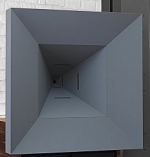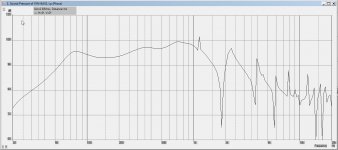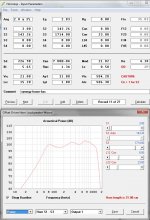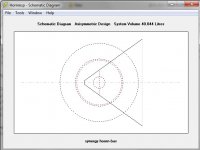Synergy and Unity horns are single point source devices, unlike the EAW Anya, PK Sound, VTC Paraline, JBL Versarray, etc. etc. which are all different ways of duplicating Christian Heil's line array concepts, patented in 1992 (filed in 1989) as used in the Vdosc line arrays, which used the HF waveguide to also house the midrange elements.PK Sound out of Canada just debuted their new array, which is Synergy Horn-ish. (Like the Danley Synergy and the EAW Anya and the VTC Paraline it has a compression driver and midranges all on a single waveguide, with a coupling chamber to reduce the apparent size of the midrange units.)
There have been incremental improvements by various designers in the past 22 years
Patent US5163167 - Sound wave guide - Google Patents
Publication number
US5163167 A
Publication type
Grant
Application number
US 07/316,919
Publication date
Nov 10, 1992
Filing date
Feb 28, 1989
Priority date
Feb 29, 1988
Fee status
Paid
Also published as
DE68915582D1, DE68915582T2, EP0331566A1, EP0331566B1
Inventors
Christian Heil
Art
Hi all
Actually, an acoustic line source is a straight line single source, acoustically large in one dimension and small in the other (like a ribbon would be). In the optical domain, it is a cylindrical lens having a focal length of infinity in one dimension and a finite dimension in the other. By infinite, that isn’t from here to the edge of the universe and back but typically 40 or 50 wavelengths where one approaches the asymptote on the curve of “change”
What the line arrays one sees in live sound are is an array of individual sources curved physically or in time electronically or both and so are an astigmatic point source, a point source with two different origins or focal lengths in the optic domain. This is done to reduce the frequency dependent effects of a line source which is not infinite in length.
It has been annoying to see how close some companies are to the intention of the Unity and Synergy horns but history is written by the winners and all the companies I have worked for were small scale and patent battles are very costly.
To be clear, some of our horns like the Jericho’s and the VTC Paraline are also astigmatic point sources as well but having some differences such as all the drivers being close enough to add coherently into one source without producing an interference pattern and having proportions which avoid pattern flip. By having a CD source, the spectral balance doesn't change appreciably with distance or location and VERY much unlike concert arrays which also require many more sources (and everything else) to reach a given audience SPL.
It is the interference pattern that allows a line array to have less fall off vs distance than an on axis point source but it is also the interference pattern (the multiple path lengths to individually radiating sources) which produces a radiation pattern where a lot more of energy is projected above and below the desired vertical angles and converts a single impulse input to the system, into multiple arrivals at the listening point.
That can be fixed for one point in space with DSP, but listening anywhere else, it is why line arrays are audibly inferior with music to a single source and why they go swish when the wind blows.
Speaking of patents, here is one that is the basis of essentially all the line arrays we see now days, note the date compared to the line arrays such as the Vdosc. Unfortunately, this was back when I was working at a NASA contractor and the company was not particularly interested in the loudspeaker business but allowed me to pursue it because it was what I loved to do. Levitation sources were “my real job” and back then was where I met Art who had a sound company that used some of the Servodrive woofers we made..
https://www.google.com/patents/US48...5iEPJOtyASZy4KYCA&sqi=2&pjf=1&ved=0CDkQ6AEwBA
It may be that we will have the resources to go after some of the “current art” which has employed some to many of the same strategies I used.
Meanwhile the stadium business has occupied all of our focus and is an area where large line arrays are ubiquitous, where the stadiums don’t care about rider compliance or who is on tour with the system and most importantly are very open to a side by side demonstration / comparisons. If you have headphones on your computer, here are a couple video’s of stadiums using the Jerhico systems, the Kinnick stadium (Iowa hawkeyes) these taken with a canon vixia hf r-300.
The first is one J-3 (just to the left of the Hawkeye) and the lf section from the J-5 Caleb (behind the hawkeye). This cabinet only covers the field for practices etc.
https://www.dropbox.com/s/mxa64hkkhkk07vj/20140805133848.mts?dl=0
The next one taken at the farthest seat or about 800 feet from the speakers (behind the perforated screen Hawkeye logo)
https://www.dropbox.com/s/lyjf0p46163q4es/20140805175937.mts?dl=0
This was at LSU (over 100,000 seats) with the loudspeakers in the side wings of the scoreboard.
https://www.dropbox.com/s/oyosfc3adc6j1du/20130723135350.mts?dl=0
at about 750 feet
https://www.dropbox.com/s/ykq1y2ugesok2se/20130723141759.mts?dl=0
At Spartan stadium in Michigan another score board system, at about 600 feet
https://www.dropbox.com/s/tnsw5mb4v5vdlwq/20120726122124.mts?dl=0
A smaller distributed system (the little boxes on the roof) a windy day at Lambau and
-5 F
https://www.dropbox.com/s/1nhx980w24ehxls/20131208154446.mts?dl=0
Best,
Tom Danley
Actually, an acoustic line source is a straight line single source, acoustically large in one dimension and small in the other (like a ribbon would be). In the optical domain, it is a cylindrical lens having a focal length of infinity in one dimension and a finite dimension in the other. By infinite, that isn’t from here to the edge of the universe and back but typically 40 or 50 wavelengths where one approaches the asymptote on the curve of “change”
What the line arrays one sees in live sound are is an array of individual sources curved physically or in time electronically or both and so are an astigmatic point source, a point source with two different origins or focal lengths in the optic domain. This is done to reduce the frequency dependent effects of a line source which is not infinite in length.
It has been annoying to see how close some companies are to the intention of the Unity and Synergy horns but history is written by the winners and all the companies I have worked for were small scale and patent battles are very costly.
To be clear, some of our horns like the Jericho’s and the VTC Paraline are also astigmatic point sources as well but having some differences such as all the drivers being close enough to add coherently into one source without producing an interference pattern and having proportions which avoid pattern flip. By having a CD source, the spectral balance doesn't change appreciably with distance or location and VERY much unlike concert arrays which also require many more sources (and everything else) to reach a given audience SPL.
It is the interference pattern that allows a line array to have less fall off vs distance than an on axis point source but it is also the interference pattern (the multiple path lengths to individually radiating sources) which produces a radiation pattern where a lot more of energy is projected above and below the desired vertical angles and converts a single impulse input to the system, into multiple arrivals at the listening point.
That can be fixed for one point in space with DSP, but listening anywhere else, it is why line arrays are audibly inferior with music to a single source and why they go swish when the wind blows.
Speaking of patents, here is one that is the basis of essentially all the line arrays we see now days, note the date compared to the line arrays such as the Vdosc. Unfortunately, this was back when I was working at a NASA contractor and the company was not particularly interested in the loudspeaker business but allowed me to pursue it because it was what I loved to do. Levitation sources were “my real job” and back then was where I met Art who had a sound company that used some of the Servodrive woofers we made..
https://www.google.com/patents/US48...5iEPJOtyASZy4KYCA&sqi=2&pjf=1&ved=0CDkQ6AEwBA
It may be that we will have the resources to go after some of the “current art” which has employed some to many of the same strategies I used.
Meanwhile the stadium business has occupied all of our focus and is an area where large line arrays are ubiquitous, where the stadiums don’t care about rider compliance or who is on tour with the system and most importantly are very open to a side by side demonstration / comparisons. If you have headphones on your computer, here are a couple video’s of stadiums using the Jerhico systems, the Kinnick stadium (Iowa hawkeyes) these taken with a canon vixia hf r-300.
The first is one J-3 (just to the left of the Hawkeye) and the lf section from the J-5 Caleb (behind the hawkeye). This cabinet only covers the field for practices etc.
https://www.dropbox.com/s/mxa64hkkhkk07vj/20140805133848.mts?dl=0
The next one taken at the farthest seat or about 800 feet from the speakers (behind the perforated screen Hawkeye logo)
https://www.dropbox.com/s/lyjf0p46163q4es/20140805175937.mts?dl=0
This was at LSU (over 100,000 seats) with the loudspeakers in the side wings of the scoreboard.
https://www.dropbox.com/s/oyosfc3adc6j1du/20130723135350.mts?dl=0
at about 750 feet
https://www.dropbox.com/s/ykq1y2ugesok2se/20130723141759.mts?dl=0
At Spartan stadium in Michigan another score board system, at about 600 feet
https://www.dropbox.com/s/tnsw5mb4v5vdlwq/20120726122124.mts?dl=0
A smaller distributed system (the little boxes on the roof) a windy day at Lambau and
-5 F
https://www.dropbox.com/s/1nhx980w24ehxls/20131208154446.mts?dl=0
Best,
Tom Danley
Tom,Hi all
To be clear, some of our horns like the Jericho’s and the VTC Paraline are also astigmatic point sources as well but having some differences such as all the drivers being close enough to add coherently into one source without producing an interference pattern and having proportions which avoid pattern flip.
Speaking of patents, here is one that is the basis of essentially all the line arrays we see now days, note the date compared to the line arrays such as the Vdosc. Unfortunately, this was back when I was working at a NASA contractor and the company was not particularly interested in the loudspeaker business but allowed me to pursue it because it was what I loved to do. Levitation sources were “my real job” and back then was where I met Art who had a sound company that used some of the Servodrive woofers we made..
https://www.google.com/patents/US48...5iEPJOtyASZy4KYCA&sqi=2&pjf=1&ved=0CDkQ6AEwBA
It may be that we will have the resources to go after some of the “current art” which has employed some to many of the same strategies I used.
Best,
Tom Danley
To set the record straight, my only "use" of the Servodrive was a 1992 comparison of a BT7 to one of my ported L2 cabinets, which incidentally used an offset driver arrangement not unlike the latter Unity and Synergy horns. Both were nominally 4 ohms, took up the same truck volume, both had near identical sensitivity and output capability using a Crest 8001 amp. The BT7 did go around 10 Hz lower (30 vs 40 Hz) but none of the music we used for testing had enough content down that low to make the difference apparent. Times have changed, content down to 25 Hz is pretty common 22 years later..
Considering the term of a patent is 20 years from the earliest filing date of the application on which the patent was granted, and there has been lots of "past art" showing pluralities of drivers loaded on single horn devices, and numerous patents granted for various devices resulting in ribbon-like output similar to your patent above, or Christian Heil's, do you (or your lawyer, hopefully with a contingency agreement favorable to you) think it possible to prevail going after some of the “current art”?
Art
Tom,
To set the record straight, my only "use" of the Servodrive was a 1992 comparison of a BT7 to one of my ported L2 cabinets, which incidentally used an offset driver arrangement not unlike the latter Unity and Synergy horns. Both were nominally 4 ohms, took up the same truck volume, both had near identical sensitivity and output capability using a Crest 8001 amp. The BT7 did go around 10 Hz lower (30 vs 40 Hz) but none of the music we used for testing had enough content down that low to make the difference apparent. Times have changed, content down to 25 Hz is pretty common 22 years later..
Considering the term of a patent is 20 years from the earliest filing date of the application on which the patent was granted, and there has been lots of "past art" showing pluralities of drivers loaded on single horn devices, and numerous patents granted for various devices resulting in ribbon-like output similar to your patent above, or Christian Heil's, do you (or your lawyer, hopefully with a contingency agreement favorable to you) think it possible to prevail going after some of the “current art”?
Art
Hi Art
My mistake, I thought I remembered a company called Southern Thunder that was a Servodrive customer and I guess I associated that with you, thought I had met you at a trade show like NAMM or something, it has been “several years” though haha.
The patent I referenced is long since expired and carries no weight other than a marker in time and as a list of other patents that came later and referenced it.
Unfortunately Intersonics had no interest in fighting to defend it and little interest in being in the loudspeaker business.
So far as the Unity and later Synergy horn patents, the patent office cites examples of prior art when objecting to the patent application.
There weren’t any at the time that were very close or sought to do the same thing and if you examine the first one of these invented 17 years ago and filed 15 years ago, you can see the number of patents which followed that and referenced it;
https://www.google.com/patents/US64...7rvHMaBygTEloHgBw&sqi=2&pjf=1&ved=0CB0Q6AEwAA
The current focus for patent enforcement right now is dealing with copies like these below as the cost to go up against any of the big guys is astronomical;
ULTIMA! - dynamikks
Best,
Tom
Yes, Southern Thunder Sound was my company, but we only demoed the BT7 , we actually met at your shop sometime shortly after I sold STS in 1992, I think I was on my way to or from the sailboat I had in Florida. You showed me the Acoustical Levitator, I talked to you through one of my Maltese horns on that occasion.Hi Art
My mistake, I thought I remembered a company called Southern Thunder that was a Servodrive customer and I guess I associated that with you, thought I had met you at a trade show like NAMM or something, it has been “several years” though haha.
The current focus for patent enforcement right now is dealing with copies like these below as the cost to go up against any of the big guys is astronomical;
ULTIMA! - dynamikks
Best,
Tom
This was a bit after I had gone "Just Plain Nuts" during the development of the Maltese horn within a horn within a horn concept, you had helped me retain some sense of reality with a phone conversation and fax exchanges during that time.
Your Unity and Synergy concepts solved the problems inherent in a nested horn approach, though the earlier conical Maltese horn was one way of doing a single point source.
Most all the major producers of line arrays use various shape entrances for their mid drivers on the same horn as used by the HF drivers, although the Dynamikks certainly looks like a Synergy, the placement of the port exits parallel to the horn mouth (the wrong way
That said, hope you could at least wrangle a licensing fee from them.
Cheers,
Art
Attachments
xrk971,
Thanks! It's an interesting measurement. It seems from the impulse response that the equalization successfully removed the lower frequency resonance of the horn, though there is a great deal of cone break-up. Is that noticeable? Do you plan to notch it out with an EQ?
I also wonder just how much HOMs are a factor here.
Here are the results of the cone breakup EQ and impact on IR - performed on the Nautaloss cabinet so that I could remove effect of the horn:
http://www.diyaudio.com/forums/full-range/259293-prv-5mr450-ndy-fast-applications-16.html#post4038839
More info on the phase from horn:
http://www.diyaudio.com/forums/full-range/259293-prv-5mr450-ndy-fast-applications-17.html#post4039247
Last edited:
If you take a properly designed Tractrix midrange horn that does not require EQ and compare it to a poorly designed one and EQ it to "match" the un-EQed one it is blatantly obvious.
Sure there will be an obvious difference, but what is the difference that is obvious? Most likely it is the different directivities of the two horns and how they interact with the room you are listening in. Given an identical anechoic on-axis response from two systems that required a different eq for the same driver, you by definition have different directivities. These two systems would have different power responses (by the amount that the directivity differed between them). You would then have different perceived in room responses and this would be easily audible. You could not actually separate out the differences in sound quality due to your eq strategy (acoustical via horn design vs electrical before the driver) from the differing power responses of the horns unless you performed your listening test in an anechoic chamber. You might prefer one over the other, but if you prefer the one that requires no electrical eq, you're probably just preferring the in-room performance of a horn that narrows its directivity as frequency increases at a rate fast enough to compensate on-axis for the driver's falling power response.
xrk971,
Thank you for posting the measurements! Seems that the horn itself is rather clean, as impulse response in the TL is not much different from the horn. Perhaps I ought to think about using such a horn to horn-load some smaller full-range driver to increase sensitivity a bit even after equalization.
Thank you for posting the measurements! Seems that the horn itself is rather clean, as impulse response in the TL is not much different from the horn. Perhaps I ought to think about using such a horn to horn-load some smaller full-range driver to increase sensitivity a bit even after equalization.
xrk971,
Thank you for posting the measurements! Seems that the horn itself is rather clean, as impulse response in the TL is not much different from the horn. Perhaps I ought to think about using such a horn to horn-load some smaller full-range driver to increase sensitivity a bit even after equalization.
If you follow the tractrix profile as prescribed by the Volvotreter spreadsheet it should work assuming the driver is well matched. What horn frequency are you aiming for? I found that I got a +10dB boost on axis with the horn so you will have an increases perceived sensitivity over a narrower cone angle.
Sure there will be an obvious difference, but what is the difference that is obvious? Most likely it is the different directivities of the two horns and how they interact with the room you are listening in. Given an identical anechoic on-axis response from two systems that required a different eq for the same driver, you by definition have different directivities. These two systems would have different power responses (by the amount that the directivity differed between them). You would then have different perceived in room responses and this would be easily audible. You could not actually separate out the differences in sound quality due to your eq strategy (acoustical via horn design vs electrical before the driver) from the differing power responses of the horns unless you performed your listening test in an anechoic chamber. You might prefer one over the other, but if you prefer the one that requires no electrical eq, you're probably just preferring the in-room performance of a horn that narrows its directivity as frequency increases at a rate fast enough to compensate on-axis for the driver's falling power response.
John Sheerin,
Thanks for clarifying this. The distinction of directivity as a function of EQ is not something I fully understand yet. However it seems that EQ'ing in DSP is not always so evil then?
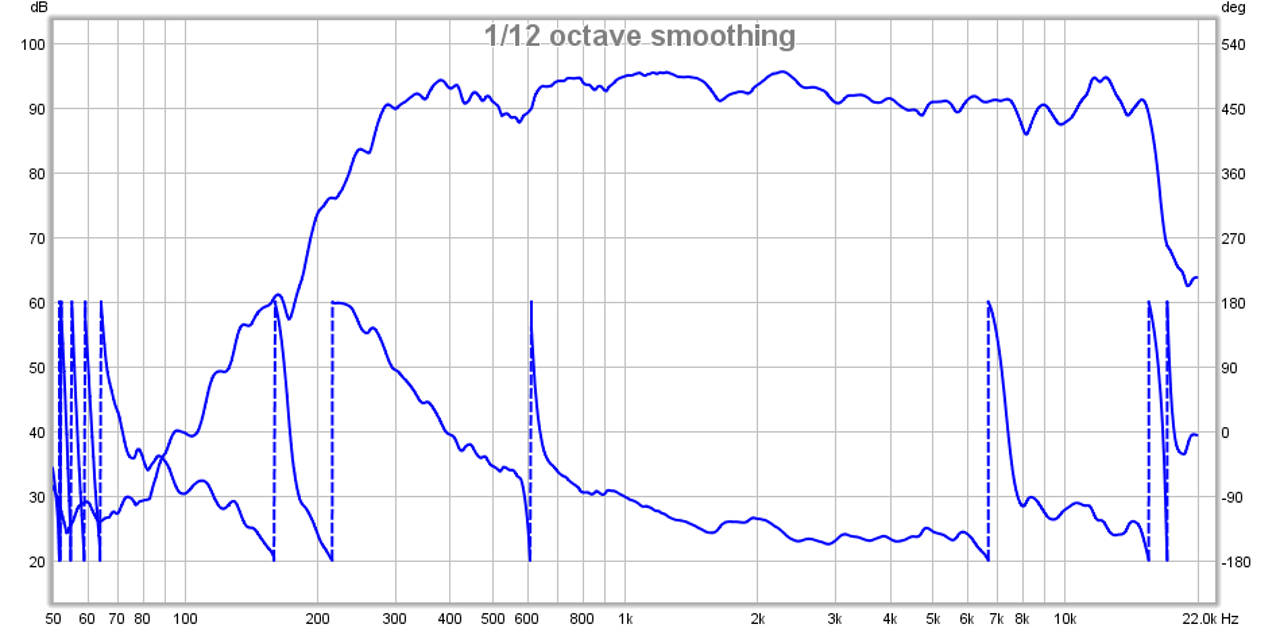
John,
What is the suitable horn for Fane Studio 8M and over what frequency range
will it work? I know that you made some horns for Studio 8M. I have a pair of these drivers.
There are multiple answers to that. What do you want it to do? Maximum usable bandwidth would lay somewhere between 70Hz and 790Hz.
Sure there will be an obvious difference, but what is the difference that is obvious? Most likely it is the different directivities of the two horns and how they interact with the room you are listening in. Given an identical anechoic on-axis response from two systems that required a different eq for the same driver, you by definition have different directivities. These two systems would have different power responses (by the amount that the directivity differed between them). You would then have different perceived in room responses and this would be easily audible. You could not actually separate out the differences in sound quality due to your eq strategy (acoustical via horn design vs electrical before the driver) from the differing power responses of the horns unless you performed your listening test in an anechoic chamber. You might prefer one over the other, but if you prefer the one that requires no electrical eq, you're probably just preferring the in-room performance of a horn that narrows its directivity as frequency increases at a rate fast enough to compensate on-axis for the driver's falling power response.
It had nothing to do with directivity, although you are correct that would be different between the examples. I've made comparisons inside and outside, therefore room effects were not a factor. Looking at the acoustical impedance will tell you most of what you need to know. You can't fake a poorly loaded driver even if you EQ it to look the same. Your ears will not be fooled.
I did see a synergy from danley who have a coaxial high mid driver and two 8 inchers, are here some peoplw who are play with this? I did plan to make home horn, so this are big enough for that.
The phillips did goh wide but the port I can not make, speaker is in the way of the tweeter driver.
SM60F from danley is such type, I think part of coaxial go behind the tweeter driver to get mid, but this I think can not be simulated.
I like tp play a lot then decide.
regards
kees
The phillips did goh wide but the port I can not make, speaker is in the way of the tweeter driver.
SM60F from danley is such type, I think part of coaxial go behind the tweeter driver to get mid, but this I think can not be simulated.
I like tp play a lot then decide.
regards
kees
I did find a synergy with a CD and two 8 inch woofers, I have use this dimensions in hornresp and akabak and get this as output.
Then I do with a bassreflex port then I see just one port in the back chamber and without it is in front, have I to use two ports of the same dimensions if i do use a bassreflex port?, however the phillips driver does wel without. using the extra flare normally seen on the synergy do sim more bad, I do not get smoother graph.
I did set lpt length to 1.80 the thickness of the used wood panels, If I did this right afcourse
I go for a conic synergy and a tratrix for testing, I am curieus about it, nice winter project.
regards kees
Then I do with a bassreflex port then I see just one port in the back chamber and without it is in front, have I to use two ports of the same dimensions if i do use a bassreflex port?, however the phillips driver does wel without. using the extra flare normally seen on the synergy do sim more bad, I do not get smoother graph.
I did set lpt length to 1.80 the thickness of the used wood panels, If I did this right afcourse
I go for a conic synergy and a tratrix for testing, I am curieus about it, nice winter project.
regards kees
Attachments
Last edited:
Directivity is not a function of EQ, EQ has no effect on directivity.The distinction of directivity as a function of EQ is not something I fully understand yet. However it seems that EQ'ing in DSP is not always so evil then?interestingly, the 1.7kHz dip I had is not due to the horn but inherent in the driver as when it was measured without horn very near field it was present. When this was EQ'd with a positive peak boost, I was expecting evil phase behavior at 1.7khz but that did not show up in measurement.
Horns like exponential or tractrix that exhibit narrowing upper directivity ("beaming") compensating for driver rolloff, so do not require the upper EQ boost that constant directivity horns like the Unity or Synergy require for flat on axis response.
Correcting a frequency response problem usually results in flatter phase response, boost a frequency response dip, and the corresponding negative phase response comes closer to flat.
Kees,Then I do with a bassreflex port then I see just one port in the back chamber and without it is in front, have I to use two ports of the same dimensions if i do use a bassreflex port?
I did set lpt length to 1.80 the thickness of the used wood panels, If I did this right afcourse
The port area can be divided in multiples equaling the same area and still tune to roughly the same frequency, as long as their depth remains the same.
It cracks me up how hard the other manufactures are trying to imitate the Synergy horn without violating the patent. This has been a great source of unintentional comedy for me.
I totally forgot to post my review of one. Check out the Multiway forum in about five minutes, I'll post it there
Kees,
The port area can be divided in multiples equaling the same area and still tune to roughly the same frequency, as long as their depth remains the same.
I do use the thickness of the wood for the length of both ports, the injection ports aswel the reflex port, however, I need two, for each speaker one, that means divede in two indeed, but I think she will be small.
I go be a whole undertaking to get the back chamber right, calculate that volume is not so easy with al these forms, maybe sketchup is of use for that,
If only mid and high then is this not so difficult with the closed mids.
regards
kees
A last thing remains.
the throat, closed rear volume etc, I presume closed rear volume is as it is for two woofers.? a possible port
there i have to devide by number of ports?
the throat I have to devide when two speakers? like throat chamber volume and throat chamber port
if i use 4 ports two per speaker then divide /4?
I need also the volume of the cone included, also here x 2 because there are two speakers.
this is the last trouble I can experience when I am not shure how to dfo it right.
thanks
regards
kees
the throat, closed rear volume etc, I presume closed rear volume is as it is for two woofers.? a possible port
there i have to devide by number of ports?
the throat I have to devide when two speakers? like throat chamber volume and throat chamber port
if i use 4 ports two per speaker then divide /4?
I need also the volume of the cone included, also here x 2 because there are two speakers.
this is the last trouble I can experience when I am not shure how to dfo it right.
thanks
regards
kees
Last edited:
1) If you use two rear chambers, that is, the drivers are not sharing a common box, then VRC is divided by 2.1)the throat, closed rear volume etc, I presume closed rear volume is as it is for two woofers.?
2)a possible port there i have to devide by number of ports?
3)the throat I have to devide when two speakers?
4)if i use 4 ports two per speaker then divide /4?
2) Huh
3)Yes.
4) Yes, four ports APT /4 .
- Home
- Loudspeakers
- Multi-Way
- Suitable midrange cone, for bandpass mid in Unity horn.
